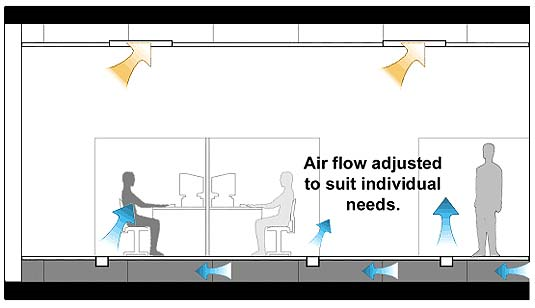Individual Comfort Controls
Existing CommercialWhat are Individual Comfort Controls?
Individual comfort controls promote occupant comfort and well-being by enabling building occupants to control airflow and temperature in individual workspaces. Individual comfort controls support flexibility within the interior environment by supporting individual adjustment for localized conditions and user preference.

Figure 1 – Underfloor air distribution systems can improve occupant comfort (Source: UC Berkeley Center for the Built Environment).
Individual comfort levels vary due to differences in clothing, activity level (metabolic rate), and individual preferences.[1] ASHRAE Standard 55, Thermal Environmental Conditions for Human Occupancy, a widely used thermal comfort measure, aim to satisfy most of the people, most of the time and combines four of the traditional comfort factors (air temperature, air humidity, radiant temperature, and airspeed) to define comfort ranges for occupants. Satisfying the people who fall outside ASHRAE’s standardized comfort bands requires individualized comfort controls at each workstation.[2]
How to Implement Individual Comfort Controls
Design the building and systems with comfort controls to allow adjustments to suit individual needs or those of groups in shared spaces. ASHRAE Standard 55 identifies the factors of thermal comfort and a process for developing comfort criteria for building spaces that suit the needs of the occupants involved in their daily activities. Control strategies can expand beyond basic comfort criteria and allow adjustments to suit individual needs and preferences. For example, individual comfort controls can involve system designs incorporating operable windows, hybrid systems integrating operable windows and mechanical systems, or mechanical systems alone (see Natural Ventilation, Energy-Efficient Windows, and Views and Operable Windows).[3] Individual adjustments may involve individual thermostat controls, local diffusers at the floor, desk or overhead levels, or control of individual radiant panels, or other means integrated into the overall building, thermal comfort systems, and energy systems design (see Smart Sensors and Controls, Glare and Heat Gain Reduction, and Daylighting). Also, designers should evaluate the closely tied interactions between thermal comfort (as required by ASHRAE Standard 55) and acceptable indoor air quality (as required by ASHRAE Standard 62.1, whether natural or mechanical ventilation).[4] Individual comfort controls can also refer to lighting controls and automatic daylighting systems and provide occupants with the ability to adjust lighting levels and reduce glare in their workspaces through task lighting or operable shading devices (see Daylighting, and High-Efficiency Lighting Systems and Networked Lighting Controls). Green building certification programs such as LEEDv4[5] and the Well Building Standard[6] give credit for including individual comfort controls.
Example
Building Users are the Key to Successful Energy Efficient Strategies
Studies of individual control of ventilation and temperature suggest energy savings, improvements in satisfaction, and a decrease in discomfort complaints. Results of a research study by Dr. Clinton Andrews and the Consortium for Building Energy Innovation showed that personal environmental control improved environmental satisfaction. The objective of the study was to evaluate the benefits of personal controls over lighting and ventilation and temperature in offices regarding occupant satisfaction, mood and visual comfort, as well as energy efficiency.[7]
Benefits
Individual comfort controls: [8]
- Improve thermal comfort for individual occupants.
- Improve air movement and ventilation effectiveness; a cleaner environment.
- Improve task lighting and reduce glare and heat gain at individual workspaces.
- Reduce building energy use.
- Lower building operating costs.
- Improve occupant satisfaction and the potential to increase worker productivity.
Costs
The cost of implementing a system that allows for individual comfort controls vary by project but is usually most cost effective when incorporated through an integrated design process (see Integrated Design Process). Higher first costs such as raised access flooring can be reduced or offset by reduced costs for ductwork, electrical services, and mechanical equipment.[9] In addition to the increased potential for improved well-being and increased productivity, enhancing thermal comfort through individual comfort controls can reduce occupant complaints and associated time spent by facilities maintenance staff. [10]
Resiliency
If the power does not go out during emergency situations and severe weather events, occupants can maintain control of the temperature and ventilation of specific areas within a building with individual controls, thus improving comfort. Individual comfort controls can decrease overall energy use and improve occupant comfort, health, and well-being, all of which can contribute to resiliency through helping occupants and communities withstand and recover from disruptions.[11]
[1] UC Berkeley. Thermal Comfort in UFAD Systems. http://www.cbe.berkeley.edu/underfloorair/thermalcomfort.htm (accessed September 10, 2018).
[2] ASHRAE Standard. Thermal Environmental Conditions for Human Occupancy. https://www.ashrae.org/technical-resources/bookstore/standard-55-thermal-environmental-conditions-for-human-occupancy (accessed September 10, 2018).
[3] Stanford University. EQ Credit 6.2: Controllability of Systems: Thermal Comfort. https://web.stanford.edu/class/cee115/wiki/uploads/Main/StudentGroup2NewBuildingAnalyisBillingsMilleaVictorsson/BillingsEQcredit6_2.pdf (accessed September 10, 2018).
[4] Chris Mueller, ASHRAE Distinguished Lecturer. ASHRAE Standard 62.1 The IAQ Procedure and LEED. https://www.epa.gov/sites/production/files/2014-08/documents/ciaq-webinar-muller.pdf (accessed September 10, 2018).
[5] USGBC. LEED v4. Thermal Controls – Controllability. https://www.usgbc.org/credits/eq62 (accessed January 19, 2019).
[6] Well Building Standard – Individual Thermal Control. https://standard.wellcertified.com/comfort/individual-thermal-control?_ga=2.191711722.134009741.1547941804-560727732.1547313140 (accessed January 19, 2019).
[7] Andrews, C.J., Senick, J.A., Wener, R.W., and M. Sorensen Allacci. (2012) “Investigating Building Performance Through Simulation of Occupant Behavior,” GreenBuild 2012 Proceedings, San Francisco, CA.
[8] UC Berkeley Center for the Built Environment. Task/Ambient Conditioning Systems. http://www.cbe.berkeley.edu/underfloorair/tacguidelines.htm (accessed September 10, 2018).
[9] UC Berkeley Center for the Built Environment. Task/Ambient Conditioning Systems. http://www.cbe.berkeley.edu/underfloorair/tacguidelines.htm (accessed September 10, 2018).
[10] Well Building Standard. Thermal Comfort. https://v2.wellcertified.com/v2.1/en/thermal%20comfort (accessed January 19, 2019).
[11] GSA. Sustainable Facilities Tool. Occupant Comfort. https://sftool.gov/learn/about/242/occupant-comfort (accessed January 19, 2019).
Resources
- Consortium for Building Energy Innovation – Empowering Energy Efficient Occupants
- GSA Sustainable Tools – Occupant Comfort
- New Jersey Office of Clean Energy
- UC Berkeley Center for the Built Environment – Research on Indoor Environmental Quality
- USGBC – LEEDv4 Thermal Comfort – controllability
- Whole Building Design Guide – Provide Comfortable Environments
